Glass Negative Collection & Traveling Exhibit
Miss Everhard - Glass Negative Collection
 During the rapid growth from the early days of Leavenworth’s founding, pioneer photographers and “daguerreotypists” took their place among the settlers.
The images they created help us see into the past and imagine early Kansas history.
During the rapid growth from the early days of Leavenworth’s founding, pioneer photographers and “daguerreotypists” took their place among the settlers.
The images they created help us see into the past and imagine early Kansas history. The Leavenworth County Historical Society holds a one-of-a-kind collection of images from the first century of Leavenworth. Heralded as a National Treasure, the LCHS has archived, preserved, and researched over 30,000 negatives from the Everhard Glass Plate Negative Collection.
The collection includes the work of early Leavenworth photographers, Richard S. Stevenson, who arrived here prior to Kansas statehood, his son Horace, and Ebenezer Elijah (E.E.) Henry and his step-son Harry Putney. Prints from the collection are available for purchase and help cover preservation costs.
Who was Miss Mary Ellen Everhard?
(1887-1971)
Glass negatives of early Leavenworth may never have come to public attention if not for the dedication to their preservation by Mary E. Everhard, a photographer who acquired the photography studio of Harrison Putney at 420 Delaware, one hundred years ago, in 1922. The purchase included a collection of glass plate negatives taken by Putney and his predecessor E. E. Henry covering over a fifty-year span of time.
When other photographers retired, Miss Everhard had the vision to procure their negatives which eventually grew to number 40,000 images (four tons of glass) and included images of Leavenworth County people and places, taking up an entire room, floor to ceiling. She cared for these negatives over the years, moving her studio twice and surviving two tornadoes, a fire, and a small flood. Not only was she a successful businesswoman and photographer, she also had the vision to save and preserve the collection of negatives until her retirement in 1968. Due to her conservation of historic images of the first city of Kansas the general public is able to experience and appreciate early Kansas history in Leavenworth today and for years to come.
What is a Glass Plate Negative?
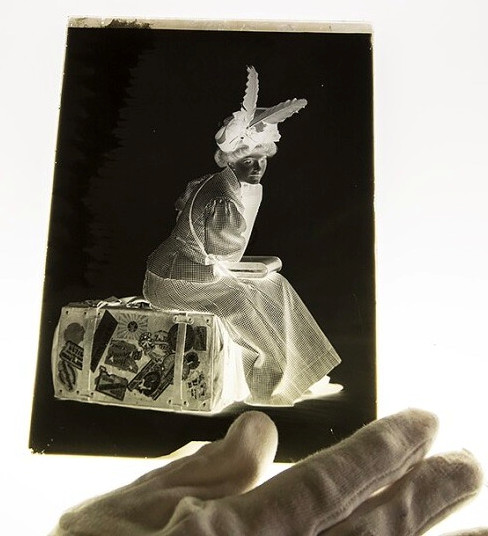 Photographs today are captured in film or digital image files, but in the late 19th century, many photographers used glass plate negatives.
There are two basic types of glass plate negatives: collodion wet plate and gelatin dry plate. Wet plate negatives, invented by Frederick
Scoff Archer in 1851, were in use from the early 1850s until the 1880s. Using glass, and not paper as a foundation, allowed for a sharper,
more stable and detailed negative, and several prints could be produced from one negative. With the wet plate process, exposure and processing
had to occur before the collodion emulsion dried, so the photographer had limited time to complete the process.
Photographs today are captured in film or digital image files, but in the late 19th century, many photographers used glass plate negatives.
There are two basic types of glass plate negatives: collodion wet plate and gelatin dry plate. Wet plate negatives, invented by Frederick
Scoff Archer in 1851, were in use from the early 1850s until the 1880s. Using glass, and not paper as a foundation, allowed for a sharper,
more stable and detailed negative, and several prints could be produced from one negative. With the wet plate process, exposure and processing
had to occur before the collodion emulsion dried, so the photographer had limited time to complete the process. Silver gelatin-coated dry plate negatives could be used whey dry and thus were more easily transported, requiring less exposure to light than the wet plates and could be developed later in the photography studio. Dry plate glass negatives were in common use between the 1880s and the late 1920s.
Both types of negatives are represented in the Everhard Collection with the majority of images being studio portraits. There are also street scenes, outdoor group portraits and residences offering a visual cross-section of citizenry and early life in Leavenworth County.
Discover Your Family in the Everhard Photograph Collection!
The Everhard Collection is a rare, fragile, irreplaceable and one-of-a-kind historical artifact. Its value will endure and be enjoyed beyond its time. We invite you to step back in history and possibly even discover your own ancestors.Since most of the collection is identified by name, the researcher of Leavenworth or Family History may discover a portrait not previously known.

View Virtual Exhibits of Glass Plate Images
The online Virtual Exhibit "Men in Uniform" featured here is an example of some of our images. We also have Victorian women, families, children, houses, clergy, weddings, babies, men with mustaches and beards, hats, etc., as subject categories in the collection.Visit the Virtual Exhibits web page to browse a variety of samples
Best viewed on laptop or desktop computer, or a mobile device in the horizontal position.
Contact the museum to conduct a search for possible family or residents names in the database. Reproduction prints are available for purchase.
Other Samples
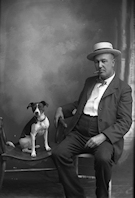
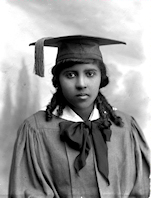
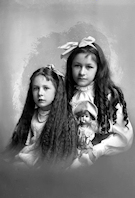
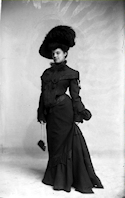
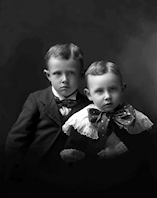
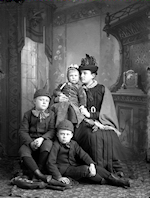
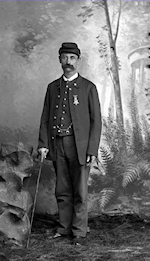
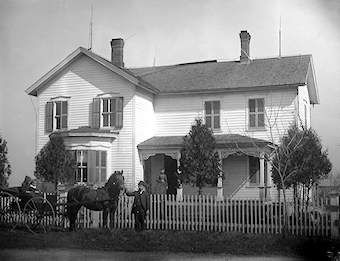
Traveling Exhibit
Photographic Treasures
 It has been said that photography is one of the greatest inventions in human history. Viewing an image taken over a century ago offers a moment captured in time and bringing it to life in the present. Photographs become recorded history and offer priceless information about humanity and nature, serving to expand human knowledge and an understanding of the past.
It has been said that photography is one of the greatest inventions in human history. Viewing an image taken over a century ago offers a moment captured in time and bringing it to life in the present. Photographs become recorded history and offer priceless information about humanity and nature, serving to expand human knowledge and an understanding of the past.Step back in time and explore Leavenworth, a small Kansas town with an enormously unique history, as chronicled in a rare photographic collection of images, taken by its pioneer photographers.
Located on bluffs and rolling hills and enclosed by a crescent of hills along the west bank of the Missouri River, Leavenworth City was organized in 1854, when the Kansas Territory was opened for settlement following the passage of the Kansas-Nebraska Act. A group of men from the Missouri River border town of Weston, Missouri, organized the Town Company. Soon, the freighting company, Majors, Russell & Waddell, received freight brought up the Missouri River by steamboat for distribution to points west. As a consequence, a wide variety of businesses made the infant city their home and the town grew rapidly only to explode in population during the Civil War due to its proximity to Fort Leavenworth. Leavenworth was destined then to become the commercial metropolis of Kansas.
The panorama of western emigration passed before the cameras of early photographers, capturing historic moments for all time in 1860s-70s Leavenworth …views of unpaved streets crammed with businesses, the first railway depot, steamboats transporting settlers and supplies, the 1871 railroad bridge over the Missouri River, and later the electric streetcar. There are also images of ordinary residents and others who became well known for their contributions to history…. President U.S. Grant, Douglas MacArthur as a youth, members of the Fred Harvey family, and ancestors of Walter Cronkite.
Miss Mary E. Everhard, a Leavenworth photographer and studio owner from 1922 to 1968, curated and preserved this historical document. Upon her retirement, the collection encompassing life in Leavenworth in its first century was sold to David R. Phillips, a photojournalist in Chicago. Phillips explored, promoted, and conserved these fragile images for the next 50 years, publishing books and articles, and selling prints of its iconic images. Although much of the collection was sold off in pieces over the years to various museums and private individuals across the United States, the Leavenworth County Historical Society now owns much of the original collection, consisting of 30,000 glass plate negatives which is considered by experts to be a national treasure.
The value of the collection is unmistakable when viewed in resultant print images of its subject matter. An enlarged print divulges long-held secrets of the past, especially evident in the stereographic negative images produced in the 1870s. Prints from a small negative can produce up to a wall size image in fine-grain detail and offer a sense of “being there.” Downtown buildings and unpaved streets, scenes along the Missouri River, and studio portraits of local residents and visitors reveal a bustling city of the past. Images captured by the premier photographer, E.E. Henry, are believed to be in a superior class of work rivaling that of Matthew Brady and Alexander Gardner of Civil War fame.
Leavenworth’s early history has been overshadowed by stories of its prisons and the Fort, but the events which occurred here----Bleeding Kansas, the era of the steamboat, freighting, the arrival of railroads, woman’s suffrage, Prohibition, and the people associated with these events should also be scrutinized, shared, and celebrated. Leavenworth’s role in our nation’s history in westward movement, contributions made by both women and men, the migration and impact made by a wide range of ethnic groups, the scope of manufacturing, and the many residents who developed a strong entrepreneurial spirit first demonstrated in Leavenworth, only to relocate to larger cities has often been overlooked and forgotten over time. Jonas Wollman, ancestor of Henry W. Bloch, James Abernathy Furniture Mfg., Otto Hesse Carriage Company, Fred Harvey, ancestors of Walter Cronkite, D. R. Anthony, and A. J. Tullock, a nationally recognized bridge builder, all had their beginnings in Leavenworth in the early days.
Leavenworth County Historical Society
One hundred years after the founding of Leavenworth, the First City of Kansas, the Leavenworth County Historical Society was organized as a non-profit 501(c)(3) in 1954 to collect, preserve, and share historical information and artifacts related to the history of Leavenworth County, Kansas. The Historical Society operates and maintains the Carroll Mansion Museum, a 16-room Queen Anne Victorian Mansion, located at 1128 Fifth Avenue, which is listed on the National Register of Historic Places. In addition to serving as an example of Victorian living in Leavenworth, the museum not only houses local artifacts but a large collection of reference materials and an extensive range of unpublished documents pertaining to local history for research. The centerpiece of our Leavenworth collection is embodied in thousands of photographic negatives, representing a century of local history, which have returned to the town of their origin and are currently owned by and housed at the museum.
Travelling Exhibit
The historical society envisioned a unique photographic exhibit, which was made possible by The Commerce Bank, Kansas City Box Gallery, Director Robin Trafton, as a reminder and re-discovery of early history in the first city of Kansas. A collection of 18 exhibit prints, 30” x 40” mounted on Di-Bond metal is currently available as a traveling exhibit. These images include downtown and city panoramas, the old Fort bridge, a steamboat, the first train depot, close-ups of downtown businesses, and studio portraits. We are able to also offer a thumb drive of additional images from the collection and several videos made about the collection to include a promotional video of our campaign to build an extension to the museum as an archive and research center of early Kansas history.
Call the Carroll Mansion Museum for details on reserving this unique traveling exhibit or how to become a hosting venue.
Ph: 913-682-7759
 https://www.visitleavenworthks.com/visitors
https://www.visitleavenworthks.com/visitors